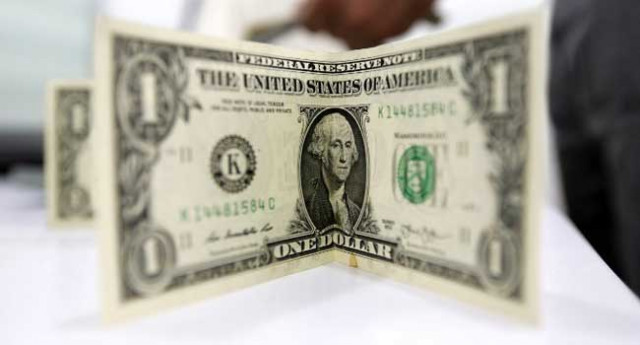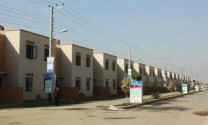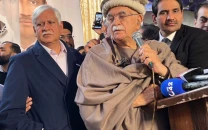Rupee closes at all-time low of 139.05 in inter-bank market
Earlier, currency had hit an intra-day record low of Rs144 to US dollar

A close-up shot of a dollar bill. PHOTO: AFP
This was the sixth round of the rupee depreciation since December 2017. On Thursday, it closed at Rs133.99. Cumulatively, the rupee has dropped 31.8%, or Rs33.55, on closing basis in the last 11 months.
The International Monetary Fund (IMF) had recently proposed that Pakistan devalue its currency to Rs145-150 to the US dollar during its talk with the newly installed Pakistan Tehreek-e-Insaf (PTI) government that is seeking a bailout package of $6-12 billion.
Government borrowing from SBP surges to historic high at Rs5.4tr
Besides, the central bank on Friday hiked the benchmark interest rate by a massive 1.5 percentage points to a six-year high of 10 per cent.
The hike in the rate was beyond market expectation for one percentage point hike, but was well in line with the IMF conditions to push the rate into double digits.
"Yes, the IMF conditioned rupee devaluation. The fact of the matter is that there was no other option left, but to devalue the rupee to avoid default on international payments,” said Pakistan Forex Association President Malik Bostan.
The devaluation of the rupee has made the dollar expensive, which is aimed at slowing down outflow of the foreign currency from the country and boost inflows. The expensive dollar would make imports costly and exports attractive.
The expansive dollar would also encourage overseas Pakistani to send higher remittances to homeland that hold the key towards increasing country's foreign currency reserves, narrowing down trade and current account deficits and improving balance of payment situation for Pakistan.
Bostan said Pakistan has received a sluggish response against its efforts to acquire a multibillion dollars soft loan from friendly counties to avoid the IMF bailout under stringent conditions.
The situation left no option but to devalue currency to avoid default on import payment and debt repayment. Pakistan is to pay around $9 billion in debt repayment by June 2019.
On the other hand, its foreign currency reserves continued to stand near and around the recent four-year low at $8.06 billion as of November 23, 2018, despite the fact that Saudi Arabia has parked $1 billion in the reserves.
Riyadh would park another $2 billion in the next two months under its friendly financial package worth $6 billion – $3 billion in cash and a credit line of another $3 billion for the supply of petroleum products to Pakistan.
Bostan said open market strictly followed the inter-bank for buying and selling dollar at retail counters. Forex.com reported it closed dollar sale at Rs142 at retail counters on Friday compared to Rs135.5 on Thursday.
The rupee devaluations in the near past and benchmark interest rate hike have helped stabilising the economy in shape of narrowing down the current account deficit, which had remained the single largest challenge for economic managers in the country.
Rupee nosedives 7.5% to record low at Rs144 in inter-bank
The central bank has said the economic data released since the last Monetary Policy Committee (MPC) meeting in September 2018 shows that the positive impact of recent stabilisation measures has started to materialise gradually. "Particularly, the current account deficit is showing early signs of improvement."
PM asks people not to panic by devaluation
Prime Minister Imran Khan on Friday said the rupee depreciation should not panic anyone because the positive economic policies of the government will ease burden on people.
“The country needs dollars to pay external debts and to manage its balance of payments,” he said while addressing inaugural ceremony of Chinese automobile JW Forland manufacturing plant in Islamabad.
Khan said foreign investors would be provided all out facilities to do business in Pakistan, transfer technology and create job opportunities. “Foreign investment not only creates jobs in the country but also brings valuable foreign exchange.”
He said the government has focused on encouraging investment, increasing exports, incentivising overseas Pakistanis for sending remittances, and checking money laundering.
He hailed the joint venture with the Chinese automobile company, which brought $900 million investment. “Earlier, there were assembly plants. This will be the first car manufacturing unit in Pakistan,” he added.
“Initially 5,000 Pakistanis would get jobs in the plant which would eventually increase to 45,000. These kinds of projects transfer technology which is the added advantage.”
Earlier, addressing the ceremony the Chinese Ambassador Yao Jing said China would always be a partner of Pakistan. He said the visit of Prime Minister Imran Khan to China proved very successful.


















COMMENTS
Comments are moderated and generally will be posted if they are on-topic and not abusive.
For more information, please see our Comments FAQ